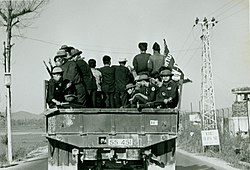South Vietnamese Popular Force
| South Vietnamese Regional Force | |
|---|---|
 Popular Self-Defence Forces head to regions to inspect possible Viet Cong infiltration during the Tet Offensive. | |
| Active | early 1960s-1975 |
| Country | South Vietnam |
| Type | Militia |
| Nickname(s) | Ruff-Puffs (used by American Forces) |
| Engagements | War in Vietnam |
During the Vietnam War, the South Vietnamese Popular Force (nghĩa quân) (sometimes abbreviated RF/PF or PF) consisted of local militias that protected their home villages from attacks by first Viet Cong forces and later by People's Army of Vietnam units. Originally called the Civil Guard and the Self-Defense Corps, they were integrated into the Army of the Republic of Vietnam in 1964 and placed under the command of the Joint General Staff. The Popular Force was one of two broad groups of militia, the other being the Regional Forces (địa phương quân). The American forces referred to both groups collectively as "Ruff-Puffs" referring to the abbreviation RF/PF. Popular Forces themselves are divided between larger and better organised Popular Forces as well as the much more provisional People's Self-Defense Forces and resembled the Local Force and village-guerrilla level component of the Viet Cong.[1] These units served on a voluntary, part-time basis and together with South Vietnamese Regional Force members, were the lowest paid and numbered almost 500,000 in 1974[2].
Initially very poorly-trained, and recruited on a voluntary basis as part-time village or area militiamen, these forces often-times bore the brunt of People's Army of Vietnam and PLAF incursions, and essentially served as front-line standing forces[3]. The abrupt U.S ground-force intervention in the war had caused many to become sidelined, due to the ARVN Regular Army being sidelined and fulfilling regional defence roles, despite being the most immediately capable of defending against guerrilla insurgency[4]. These units became gradually better-trained and equipped during Vietnamization, and experienced doubled the casualties of Army of the Republic of Vietnam Regular Forces from 1970 on-wards. Nevertheless RF/PF units were responsible for inflicting an estimated 30% of the total People's Army of Vietnam and Viet Cong casualties throughout the war [5], and were much more capable of fulfilling ambush and small-unit movement, reconnaissance and detection roles than larger, slow-moving conventional forces[6].

Female members of the People's Self-Defense Force of Kien Dien, in Bến Cát District. The PSDF was a more local-level force responsible for guarding hamlets and homes.
Contents
1 History
2 External links
3 References
History
From 1965-1969, the ARVN took over most security operations as the Americans and other allies fought the main force war against the PAVN and NLF. When U.S. forces began to withdraw in 1969, the ARVN took on the task of fighting the communists, the Regional Forces and Popular Forces took on new importance. For the first time, they were deployed outside their home areas and were sometimes attached to ARVN units.
By 1973 the Popular forces consisted of 8,186 platoons. Charged primarily with local defense, they were too lightly armed and equipped to withstand attacks by PAVN units supported by tanks and artillery. They were overwhelmed during the 1975 Spring Offensive and dissolved.
External links
References
^ https://www.vietnam.ttu.edu/star/images/1127/11270103001a.pdf
^ Wiest, Andrew (2009-10). Vietnam's Forgotten Army: Heroism and Betrayal in the ARVN. NYU Press. pp. 73–77. ISBN 9780814794678. Check date values in:|date=(help)
^ Jr, Ronald B. Frankum (2011-06-10). Historical Dictionary of the War in Vietnam. Scarecrow Press. ISBN 9780810879560.
^ Wiest, Andrew (2009-10). Vietnam's Forgotten Army: Heroism and Betrayal in the ARVN. NYU Press. p. 49. ISBN 9780814794678. Check date values in:|date=(help)
^ Krepinevich, Andrew F. (1986-05-01). The army and Vietnam. Johns Hopkins University Press. pp. 219–222. ISBN 9780801828638.
^ Emerson, Gloria (1970-08-16). "'Ruff Puffs,' Vietnamese Militia, Hunt Enemy by Night". The New York Times. ISSN 0362-4331. Retrieved 2018-05-28.

 Clash Royale CLAN TAG#URR8PPP
Clash Royale CLAN TAG#URR8PPP